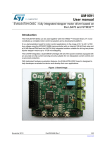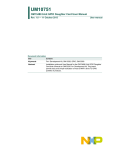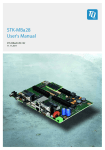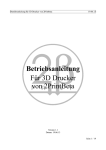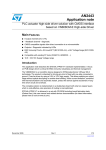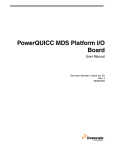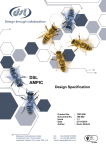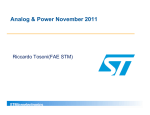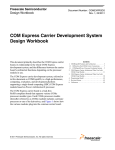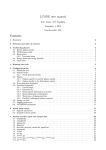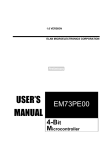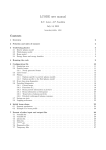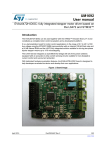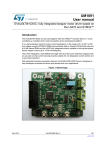Download User Manual V1.1
Transcript
User's Guide for the BAM Shield with DICE boards 12. Nov. 2014 User Manual BAM-Shield with DICE-Boards Version: 1.0en Author: Konrad Meyer Date: 12. Nov. 2014 Page 1 / 13 User's Guide for the BAM shield 12. Nov. 2014 Index 1 Important notes.................................................................................................................................3 1.1 Warning notices........................................................................................................................3 1.2 General precautions..................................................................................................................4 1.3 Additional notes........................................................................................................................4 2 Components......................................................................................................................................5 2.1 BAM shield...............................................................................................................................5 2.1.1 Specification......................................................................................................................5 2.1.2 Connections.......................................................................................................................6 2.2 DICE-STK................................................................................................................................7 2.2.1 Specification......................................................................................................................7 2.2.2 Utilization..........................................................................................................................7 2.3 DICE-TMC...............................................................................................................................8 2.3.1 Specification......................................................................................................................8 2.3.2 Utilization..........................................................................................................................8 2.4 DICE-L6470.............................................................................................................................9 2.4.1 Specification......................................................................................................................9 2.4.2 Utilization..........................................................................................................................9 2.5 DICE-9555..............................................................................................................................10 2.5.1 Specification....................................................................................................................10 2.5.2 Utilization........................................................................................................................10 2.6 DICE-TC.................................................................................................................................11 2.6.1 Specification....................................................................................................................11 2.6.2 Utilization........................................................................................................................11 2.7 DICE-VN................................................................................................................................12 2.7.1 Specification....................................................................................................................12 2.7.2 Utilization........................................................................................................................12 3 Applications....................................................................................................................................13 History Version V1.0en Description First English version Copyright 2014 © Wenger & Krautwasser GbR Author K. Meyer Date 12.11.2014 Page 2 / 13 User's Guide for the BAM shield 12. Nov. 2014 Congratulations on your purchase of the universal BAM Shield from 2PRINTBETA. Please read the instructions carefully before setting the device in operation. Please also take note of the general safety instructions. 1 Important notes Please observe all instructions given in this manual and read this information carefully before using the product. 1.1 Warning notices Safety (Warning / Caution) • Any operating conditions, such as use in hazardous areas, use in safety-related systems and areas in which the loss of function may present a particular risk to life and limb are prohibited with this product. • Do not place any objects around the device, which prevent a dissipation of heat. • Do not place flammable materials and substances in the environment of the device. • Take care that no metal objects touch the electronics when using the product. • Use for all interfaces matching plugs and wires. • Use only components that are within the given specifications. • Do not expose the device to liquids or corrosive substances. • Operate the unit in a clean, dry and dust free environment. • Should the structure be contaminated, disconnect the unit from the mains (remove the power plug and disconnect the PCB from the power supply) and gently clean it. • Never let the appliance run unattended. • This kit is designed for self assembly and construction. The finished device can generate and radiate high-frequency signals. The operation of the product may impair or interfere with other electronic devices during operation depending on the type of setup. You are hereby expressly advised of this risk and you should take the necessary measures to prevent this types of interference. Each completed unit must be tested for long-term operation to comply with applicable regulatory limits. • The responsibility for the security of a constructed machine lies at the builder and operator of the system. Copyright 2014 © Wenger & Krautwasser GbR Page 3 / 13 User's Guide for the BAM shield 12. Nov. 2014 1.2 General precautions General operating conditions: • Operate the device only in the final build up of the proposed hardware and with sufficient cooling. • This device is sensitive to mechanical and physical influences. • Turn off the power supply and remove the mains plug before making any changes to the installation and wiring of the setup. Not to do so may destroy your electronics and attached equipment. • The device may be used only for the intended purpose within the limits of the electrical specification. 1.3 Additional notes Protection against electrostatic discharges The unit is equipped with electronic components that can easily be destroyed by electrostatic discharges. Use the usual measures to protect the components when you install or use the device. Not suitable for children The device is not suitable for toddlers and children. Make sure that small parts and accessories are kept safe and that the unit is protected against contact when children may be present in the vicinity of the device. Also make sure that your required tools are not in the reach of children and infants. Recycling and re-use The product contains substances which must not be disposed in household waste (European directive 2002/96/EG). Please give this product to a designated location. Improper handling of components whose components consist of potentially dangerous or harmful substances can cause damage to the environment and can endanger humans, animals and plants. Dispose this product properly and contribute to the effective usage of natural resources. Your dealer will certainly help you. You can also return the device to an authorized collection site for recycling electrical waste and electronic equipment. For information about waste recycling, please contact your city office, the public waste companies or an authorized site for the disposal of electrical and electronic equipment. Copyright 2014 © Wenger & Krautwasser GbR Page 4 / 13 User's Guide for the BAM shield 12. Nov. 2014 2 Components The kit of BAM&DICE includes the BAM shield and additional DICE boards for the individual user dependent applications. For software examples for each module and complete firmwares in specialized setups please visit www.2printbeta.de. 2.1 BAM shield Picture 1: BAM shield with Arduino, without other components 2.1.1 Specification • Input 1: • • • • • • • • • • Imax = 15A* 12V-Variante: +8V .. 18V (without DC/DC converter) 24V-Variante: +16V .. 32V (with DC/DC converter) Input 2: Imax = 10A* +8V .. 32V Logic voltage: +5V Interface for Arduino Mega 1280 and 2560 Configurable slots with jumpers 3 high current switches with up to 10A Power connection over screw termination blocks Diverse connections for expansions Over-current fuses with 10A and 15A Everything open source. Schematics, layout and firmware available Five DICE board connectors for individual controller extensions The board is not reverse polarity protected. Always pay attention to the correct polarity! (*) The fuses can also be switched in case of heavy loads at high current switch D8. When inserting and wiring equipment to the board, be sure that the power supply is switched off. Copyright 2014 © Wenger & Krautwasser GbR Page 5 / 13 User's Guide for the BAM shield 2.1.2 12. Nov. 2014 Connections Picture 2: Pin assignment of the BAM shield Pin name Description VIN1, GND Power input for DICEs, Arduino and loads at high current switches D9 and D10 VIN2, GND Power input for load at high current switch D8 Vout1 Power output from VIN1, fused Vout2 Power output from VIN2, fused D10, D9, D8 High current switches for loads (low side switched) Vcc +5V power rail (Arduino generates this voltage) +5V_EXT External 5V power rail for additional servomotors D12, D11, D6,D5,D4, TXD, RXD, A3, A4, A5,A9, A10, D40, D44, D42, A12, A11, SCK, MISO, D53, MOSI, D49, D32, D47, D45, D43, D41, D39, D37, D35, D33, D31, D29, D27, D25, D23, D17, D16, SDA, SCL, X-MIN, X-MAX, Y-MIN, Y-MAX, ZMIN, Z-MAX Digital I/Os of the Arduino MS3, MS2, MS1 Jumper for microstepping settings and I²C addresses (for each DICE slot individually) Copyright 2014 © Wenger & Krautwasser GbR Page 6 / 13 User's Guide for the BAM shield 12. Nov. 2014 2.2 DICE-STK Motor connections A1,A2, B1, B2 Potentiometer for motor currents Potentiometer for decay setting Picture 3: DICE-STK Stepper driver 2.2.1 • • • • • • • Specification Logic voltage: 5V Power voltage for motor: +9V .. 32V Control via STEP/DIR interface Without cooling up to 2A (65°C). Up to 2.86A with cooling air flow. Substepping: 1, 1/2, 1/4, 1/8, 1/16, 1/32, 1/64, 1/128 Two trimmers for phase currents and decay setting Size: 51x43mm 2.2.2 Utilization The DICE-STK drivers are controlled by the so-called STEP/DIR interface, i.e. the state (enable/disable), direction (CW, CCW) and step pulses (STEP) are logic signals from the microcontroller. The signals of the MS1..MS3 pins for the respective DICE slot define the microstepping. A ' 1 ' in the table defines the plugged jumper. Jumper setup MS3, MS2, MS1 Substepping Jumper setup MS3, MS2, MS1 Substepping 0 0 0 No substepping 1 0 0 1/16 0 0 1 1/2 1 0 1 1/32 0 1 0 1/4 1 1 0 1/64 0 1 1 1/8 1 1 1 1/128 Copyright 2014 © Wenger & Krautwasser GbR Page 7 / 13 User's Guide for the BAM shield 12. Nov. 2014 2.3 DICE-TMC High precision stepper driver with SPI interface and additional STEP/DIR interface. Motor connections A2, A1, B1, B2 Picture 4: DICE-TMC Stepper driver 2.3.1 • • • • • • • • 2.3.2 Specification Logic voltage: 3,3V / 5V (configurable) Supply voltage: +9V .. 30V Control via SPI and STEP/DIR interface Current: 2.6A RMS (4A max.) Substepping: 1, 1/2, 1/4, 1/8, 1/16, 1/32, 1/64, 1/128, 1/256 Completely software configurable Stall detection Size: 51x44mm Utilization The DICE-TMC drivers are controlled by SPI and feature an additional step- and a direction input (DIR) for the synchronous control with other modules. The signals MS1..MS3 on the BAM shield are not used. To use the module in a special setup we recommend the pre-configured Arduino library, which you can download with an example program for the first steps on our website. It is possible to configure the module to lower logic voltages. To do this change the solder jumper on the topside. For more information please use the wiring diagram of the module and the datasheet of TMC2660. Copyright 2014 © Wenger & Krautwasser GbR Page 8 / 13 User's Guide for the BAM shield 12. Nov. 2014 2.4 DICE-L6470 Motor connections B1, B2, A2, A1 Picture 5: DICE-L6470 Stepper driver 2.4.1 • • • • • • • • 2.4.2 Specification Logic voltage: +3.3V/ 5V (configurable) Supply voltage: +9V .. 35V Control via SPI and STEP input Up to 3ARMS. Up to 7A max. Substepping: 1, 1/2, 1/4, 1/8, 1/16, 1/32, 1/64, 1/128 Completely software configurable Sensorless stall detection Size: 51x44mm Utilization The DICE-L6470 drivers are controlled via the SPI and offers an additional step input for synchronous operation. The signals of the MS1..MS3 pins from the BAM shield are not used. For utilization we recommend to setup the module with an appropriate Arduino library. On your website you can download it and also a suitable code example for the first steps. The configuration to lower logic voltages is also possible. For this you have to change the solder jumper on the backside to 3V3 and place a jumper on resistor R7. For further information please refer to the schematics and the datasheet of L6470PD. Copyright 2014 © Wenger & Krautwasser GbR Page 9 / 13 User's Guide for the BAM shield 12. Nov. 2014 2.5 DICE-9555 IO port expander with 16 digital signal lines and power output Picture 6: DICE-9555 2.5.1 • • • • • • • 2.5.2 Picture 7: DICE-9555 connection Specification Logic voltage:: +5V, +3V3 (configurable) Control via I2C-interface (max. 400kHz) Up to 50mA per pin and 200mA overall current 16 configurable I/O pins Interrupt signal for detection of signal changes Short circuit protected output voltage (200mA) Size: 51x31mm Utilization The signals MS1..MS3 on the BAM shield are used to define the I2C address of the module. The usable address range lies between 32d (100000b) and 39d (100111b). With the first use of this module we recommend the example program from our website. It is possible to configure the module to lower logic voltages. To do this, change the solder jumper on the topside. For more information please use the wiring diagram of the module and the datasheet of PCA9555PW. Copyright 2014 © Wenger & Krautwasser GbR Page 10 / 13 User's Guide for the BAM shield 12. Nov. 2014 2.6 DICE-TC Temperature measurement unit for three thermocouples (K type) with SPI interface Thermocouple input 1 Thermocouple input 2 Thermocouple input 3 Picture 8: DICE-TC 2.6.1 • • • • • • 2.6.2 Specification Logic voltage: +5V, +3V3 (configurable) Control via SPI 3 channels for thermocouples Measurement range: -200°C to 700°C (-328°F to 1292°F) Automatic error detection (short, no sensor) Size: 51x44mm Utilization The signals MS1..MS3 on the BAM shield are not used by this module. For the reading of each temperature value, the chip select signal of the corresponding channel must be enabled by the corresponding GPIOs. You can find an example and a suitable Arduino library for this module on our website on the product page. It is possible to configure the board for lower logic voltages. To do this, remove the Zero-Ohm resistor from R3 and place it (or a jumper) on R2. For more information please use the wiring diagram of the module and the datasheet MAX31855. Copyright 2014 © Wenger & Krautwasser GbR Page 11 / 13 User's Guide for the BAM shield 12. Nov. 2014 2.7 DICE-VN Valve driver with 8 channels for relays and actuators Outputs 1..4 Outputs 5..8 4x GND Picture 9: DICE-VN 2.7.1 • • • • • • 2.7.2 Specification Logic voltage: +5V, +3V3 (configurable) Control via I2C interface (max. 400kHz) Supply voltage: 10,5 - 35V Current: 0,7 A per output (4A in sum) I²C addresses: 112d .. 115d (111000b .. 111011b) Size: 51 x 44 mm Utilization The signals MS1 and MS3 on the BAM-Shield can be used to set the I2C address for the module. After configuring the I2C chip (PCA9538A) in the software, it can set the outputs of the power driver VN808CM-E. For the first use of this module we recommend the example program from our website. It is possible to configure this module for lower logic voltages. To do this, change the setting of the solder jumper on the backside. For more information please use the wiring diagram of the module and the datasheets of the components PCA9538A and VN808CM-E. Copyright 2014 © Wenger & Krautwasser GbR Page 12 / 13 User's Guide for the BAM shield 12. Nov. 2014 3 Applications Picture 10: Wiring diagram of BAM&DICE in a 3D printer with the DICE-STK drivers Copyright 2014 © Wenger & Krautwasser GbR Page 13 / 13













